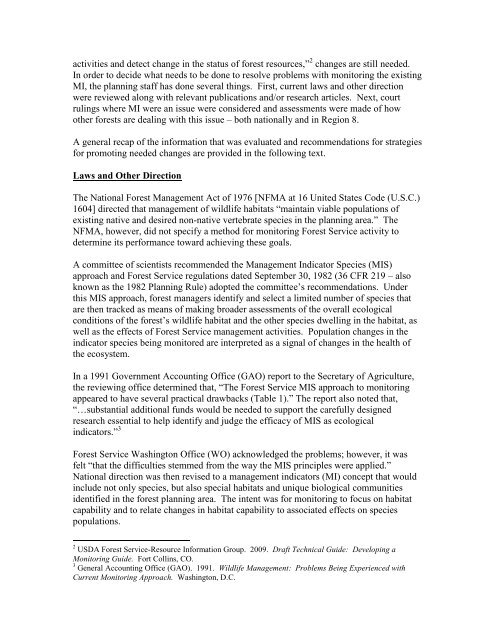A White Paper Discussing Management Indicator Species (MIS)
A White Paper Discussing Management Indicator Species (MIS)
A White Paper Discussing Management Indicator Species (MIS)
You also want an ePaper? Increase the reach of your titles
YUMPU automatically turns print PDFs into web optimized ePapers that Google loves.
activities and detect change in the status of forest resources,” 2 changes are still needed.<br />
In order to decide what needs to be done to resolve problems with monitoring the existing<br />
MI, the planning staff has done several things. First, current laws and other direction<br />
were reviewed along with relevant publications and/or research articles. Next, court<br />
rulings where MI were an issue were considered and assessments were made of how<br />
other forests are dealing with this issue – both nationally and in Region 8.<br />
A general recap of the information that was evaluated and recommendations for strategies<br />
for promoting needed changes are provided in the following text.<br />
Laws and Other Direction<br />
The National Forest <strong>Management</strong> Act of 1976 [NFMA at 16 United States Code (U.S.C.)<br />
1604] directed that management of wildlife habitats “maintain viable populations of<br />
existing native and desired non-native vertebrate species in the planning area.” The<br />
NFMA, however, did not specify a method for monitoring Forest Service activity to<br />
determine its performance toward achieving these goals.<br />
A committee of scientists recommended the <strong>Management</strong> <strong>Indicator</strong> <strong>Species</strong> (<strong>MIS</strong>)<br />
approach and Forest Service regulations dated September 30, 1982 (36 CFR 219 – also<br />
known as the 1982 Planning Rule) adopted the committee’s recommendations. Under<br />
this <strong>MIS</strong> approach, forest managers identify and select a limited number of species that<br />
are then tracked as means of making broader assessments of the overall ecological<br />
conditions of the forest’s wildlife habitat and the other species dwelling in the habitat, as<br />
well as the effects of Forest Service management activities. Population changes in the<br />
indicator species being monitored are interpreted as a signal of changes in the health of<br />
the ecosystem.<br />
In a 1991 Government Accounting Office (GAO) report to the Secretary of Agriculture,<br />
the reviewing office determined that, “The Forest Service <strong>MIS</strong> approach to monitoring<br />
appeared to have several practical drawbacks (Table 1).” The report also noted that,<br />
“…substantial additional funds would be needed to support the carefully designed<br />
research essential to help identify and judge the efficacy of <strong>MIS</strong> as ecological<br />
indicators.” 3<br />
Forest Service Washington Office (WO) acknowledged the problems; however, it was<br />
felt “that the difficulties stemmed from the way the <strong>MIS</strong> principles were applied.”<br />
National direction was then revised to a management indicators (MI) concept that would<br />
include not only species, but also special habitats and unique biological communities<br />
identified in the forest planning area. The intent was for monitoring to focus on habitat<br />
capability and to relate changes in habitat capability to associated effects on species<br />
populations.<br />
2<br />
USDA Forest Service-Resource Information Group. 2009. Draft Technical Guide: Developing a<br />
Monitoring Guide. Fort Collins, CO.<br />
3<br />
General Accounting Office (GAO). 1991. Wildlife <strong>Management</strong>: Problems Being Experienced with<br />
Current Monitoring Approach. Washington, D.C.
















